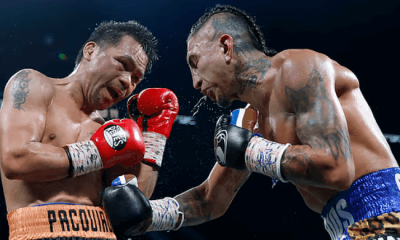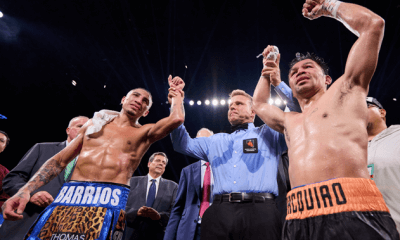Featured Articles
Life, Death and Boxing
 In 1519, Spanish explorer Alonso Álvarez de Pineda discovered a sleepy bay on the South Texas coastline. He named the settlement Corpus Christi in honor of a Catholic feast day celebrating the Body of Christ.
In 1519, Spanish explorer Alonso Álvarez de Pineda discovered a sleepy bay on the South Texas coastline. He named the settlement Corpus Christi in honor of a Catholic feast day celebrating the Body of Christ.
The last time I traveled down to the area was to see now-paralyzed boxer Paul Williams in what would turn out to be his last professional prizefight. Williams outclassed Nobuhiro Ishida over 12 rounds in February 2012 to run his ring record to an impressive 41 wins, 2 losses with 27 KOs. That May, the 30-year-old Williams was involved in a tragic motorcycle accident that has since robbed him of his mobility from the waist down. I could not help but to reflect on Williams as my wife, Rachel, and I made the three-hour trek from Houston to Corpus Christi last November to see Mikey Garcia face Rocky Martinez in the very same venue as Williams’ last fight.
The last time I saw Paul, he stood tall in a red jumpsuit, eyes bright and wide, brimming with confidence about a certainly bright future. I’m told he’s the same now, save for he rises just about halfway as high from the ground as he used to now that he’s confined to an altitude of a wheelchair.
Boxing isn’t short of tragedies. As my headlights peer through the darkness to reveal the winding of the ever approaching highway, my wandering mind rests on the recently passed Frankie Leal. Leal was killed by Raul Hirales last year in Cabo San Lucas, Mexico. Leal was down once in Round 6 and again in Round 8. He died three days later from a brain injury sustained during the fight. I was ringside 19 months earlier when Leal was put into the hospital for three days due to reported swelling of the brain. Leal was knocked out by Evgeny Gradovich in March 2012 in San Antonio. He was outslugged for 10 rounds and hauled out on a stretcher after the fight was stopped at 2:15 of the very last round. I never thought the kid would fight again, but he fought five more times after. He shouldn’t have. Now he’s dead.
Magomed Abdusalamov isn’t dead. But the heavyweight will never be the same. Abdusalamov had a blood clot as well as part of his skull removed following a 10-round decision loss to Mike Perez last November. The fight was a clear win for Perez but didn’t appear to be the kind of butchering that should raise an alarm until after Abdusalamov ended up in the hospital. Abdusalamov went to the hospital afterwards with a headache before being placed into a medically induced coma by his doctors. The 32-year-old, a married father of three young daughters, eventually awoke and is now facing a grueling recovery that may make up the better part of the rest of his life. He may never be the same.
Boxing is a dangerous sport. And some say boxing should be no more.
I disagree, though I’m not sure I can now put it into words. After all, I’m driving now, and Rachel and I are doing mundane things like looking for a place to eat. It’s Wednesday night. We take the exit towards a town named Victoria because Rachel thinks it’s larger than it turns out to be. No dice. There are absolutely no restaurants worthy of our presence. We end up a few miles down the road at a little Mexican seafood place in a town called Refugio. It’s good, and we’re glad we practiced some patience to get there.
Soon we’re heading towards Corpus Christi. We’re silent now as we listen to the new album from a Canadian band called Arcade Fire. The music is full of emotion. It is life in the form of song. There are no subjects off limits. We drive through the darkness until we make our way to our hotel on the beach. It’s an older hotel, but the price was right and the location can’t be beat. We enjoy a few glasses of red wine before heading to bed. We discuss many things before sleep takes us – Paul Williams, our friends in boxing and how increasingly difficult it is becoming for a person to be religious in a secular world.
No matter, we’re happy to be here. We’re happy to be alive.
We wake up late on Thursday morning. Real life beckons more than I’d like. I end up working my day job for most of the morning. I manage a team of technical writers for a well known oil and gas company. I work all morning why Rachel waits patiently for me to finish. In the end, I’ve worked past the day’s press conference at the local museum. No matter, we’ll have a good day.
We end up eating Tex-Mex at a local eatery. Next, we visit the Texas State Aquarium. Two dolphins and their trainers provide entertainment beyond what we believed possible for sea mammals to do. Soon, we’re casing the coastline, looking for a rocky pier to walk out onto together. We love the ocean. We love the waves and the sounds of the water as it rumbles around us. Soon we’ve found a perfect place to experience it. We’re standing at the edge of a pier, waves crashing around us, looking out into the great beyond. We cannot control the ocean. It is beyond us.
We chat about the day. We visited a cemetery that day while the daylight still kept us warm. Rachel and I are Catholic. The beginning of the month was All Souls’ Day, the time when all the Catholic Church prays for the poor souls in purgatory making their way into heaven. We stop by a cemetery, one where we see there is a statue of Our Lady of Guadalupe, the Virgin Mary. We pray to her on our knees. Afterwards, we walk around the small group of headstones, complicit with the sadness of the flowers. There is a headstone in the corner. I make my way to it. It is small and off alone by itself. I notice a small marking upon it. Is that a tiny light saber? The kind from the Star Wars movies? It is, and I wonder if a small scrap of worldliness has blown upon this marker of the dead. No, it’s a sticker on the tombstone. Oh, I think…it’s someone who really liked the movies. Cool. This old man loved Star Wars. But no…wait. I notice the dates etched into the rock. This person, this young boy, died at age 6. There are more than just stickers on his stone. There are little windup trucks lying around it, too. One is turned on its side. I pick it up and place it upright for him. It is devastating. I cannot help but weep at his passing. He was only six years old. He loved Star Wars and little windup trucks. I’m sobbing now. Sobbing.
I remember these things in silence as I hold my wife near the crashing waves. We are safe here. For now. But somewhere out there in the world, there is pain and hurt. Paul Williams sits in a wheelchair, Frankie Leal is dead, Magomed Abdusalamov struggles with the effects of brain trauma, and a little boy who loved Star Wars rests in the ground while I weep for him.
-

 Featured Articles3 weeks ago
Featured Articles3 weeks agoResults and Recaps from New York Where Taylor Edged Serrano Once Again
-

 Featured Articles5 days ago
Featured Articles5 days agoThe Hauser Report: Zayas-Garcia, Pacquiao, Usyk, and the NYSAC
-

 Featured Articles3 weeks ago
Featured Articles3 weeks agoResults and Recaps from NYC where Hamzah Sheeraz was Spectacular
-

 Featured Articles4 weeks ago
Featured Articles4 weeks agoFrom a Sympathetic Figure to a Pariah: The Travails of Julio Cesar Chavez Jr
-

 Featured Articles2 weeks ago
Featured Articles2 weeks agoManny Pacquiao and Mario Barrios Fight to a Draw; Fundora stops Tim Tszyu
-

 Featured Articles3 weeks ago
Featured Articles3 weeks agoPhiladelphia Welterweight Gil Turner, a Phenom, Now Rests in an Unmarked Grave
-

 Featured Articles2 weeks ago
Featured Articles2 weeks agoArne’s Almanac: Pacquiao-Barrios Redux
-

 Featured Articles4 weeks ago
Featured Articles4 weeks agoCatterall vs Eubank Ends Prematurely; Catterall Wins a Technical Decision

















